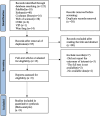Efficacy of electroacupuncture in the treatment of insomnia in cancer patients: A meta-analysis
- PMID: 40184112
- PMCID: PMC11709210
- DOI: 10.1097/MD.0000000000041123
Efficacy of electroacupuncture in the treatment of insomnia in cancer patients: A meta-analysis
Abstract
Background: The purpose of this meta-analysis of current studies was to assess the efficacy of electroacupuncture for cancer-related insomnia.
Methods: A comprehensive search was conducted encompassing randomized controlled trials examining the efficacy of electroacupuncture in treating cancer-related insomnia across CNKI, VIP, Wang Fang, PubMed, Embase, Cochrane library, and Web of Science, with a search deadline of December 26, 2023. The Cochrane manual's risk-of-bias evaluation was used for quality assessment, while Stata 15.0 was used for the data analysis.
Results: Eight randomized controlled studies involving 537 individuals were finally included. Meta-analysis results suggested that electroacupuncture improved total sleep time [SMD = 0.68, 95% CI (0.31, 1.06)], sleep efficiency [SMD = 1.26, 95% CI (0.02, 2.50)], and reduced Pittsburgh sleep quality index [SMD = -0.44, 95% CI (-0.63, -0.25)], insomnia severity index [SMD = -1.23, 95% CI (-1.88, -0.58)], and sleep onset latency [SMD = -0.76, 95% CI (-1.36, -0.15)] in cancer patients.
Conclusion: Based on the current study, we found that electroacupuncture may have a better effect on insomnia in cancer patients.
Copyright © 2025 the Author(s). Published by Wolters Kluwer Health, Inc.
Conflict of interest statement
The authors have no conflicts of interest to disclose.
Figures








Similar articles
-
Efficacy of electroacupuncture for insomnia in cancer patients: a systematic review and meta-analysis.Front Neurol. 2025 Feb 10;16:1512052. doi: 10.3389/fneur.2025.1512052. eCollection 2025. Front Neurol. 2025. PMID: 39995786 Free PMC article.
-
The effects of acupuncture versus sham/placebo acupuncture for insomnia: A systematic review and meta-analysis of randomized controlled trials.Complement Ther Clin Pract. 2020 Nov;41:101253. doi: 10.1016/j.ctcp.2020.101253. Epub 2020 Nov 1. Complement Ther Clin Pract. 2020. PMID: 33186824
-
Efficacy and safety of electroacupuncture for secondary sleep disorders: A meta-analysis and systematic review.Medicine (Baltimore). 2023 Jun 30;102(26):e34150. doi: 10.1097/MD.0000000000034150. Medicine (Baltimore). 2023. PMID: 37390293 Free PMC article.
-
Electroacupuncture for primary insomnia: Protocol for a systematic review and meta-analysis.Medicine (Baltimore). 2018 Jul;97(27):e11063. doi: 10.1097/MD.0000000000011063. Medicine (Baltimore). 2018. PMID: 29979377 Free PMC article.
-
Cognitive behavioural therapy monotherapy for insomnia: A meta-analysis of randomized controlled trials.Asian J Psychiatr. 2020 Mar;49:101828. doi: 10.1016/j.ajp.2019.10.008. Epub 2019 Oct 13. Asian J Psychiatr. 2020. PMID: 32115395 Review.
References
-
- van Hoogstraten LMC, Vrieling A, van der Heijden AG, Kogevinas M, Richters A, Kiemeney LA. Global trends in the epidemiology of bladder cancer: challenges for public health and clinical practice. Nat Rev Clin Oncol. 2023;20:287–304. - PubMed
-
- Emery J, Butow P, Lai-Kwon J, Nekhlyudov L, Rynderman M, Jefford M. Management of common clinical problems experienced by survivors of cancer. Lancet. 2022;399:1537–50. - PubMed
-
- Chen D, Yin Z, Fang B. Measurements and status of sleep quality in patients with cancers. Support Care Cancer. 2018;26:405–14. - PubMed
-
- Hoang HTX, Molassiotis A, Chan CW, Nguyen TH, Liep Nguyen V. New-onset insomnia among cancer patients undergoing chemotherapy: prevalence, risk factors, and its correlation with other symptoms. Sleep Breath. 2020;24:241–51. - PubMed
Publication types
MeSH terms
LinkOut - more resources
Full Text Sources
Medical

